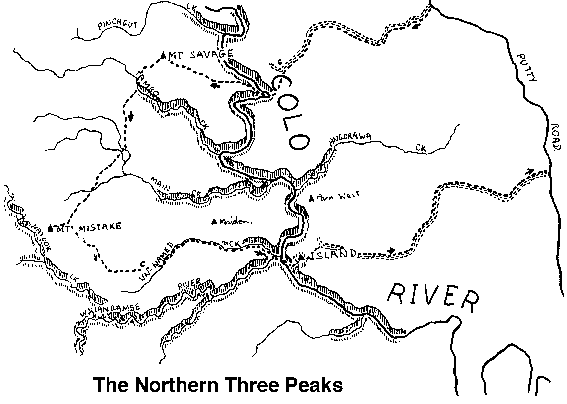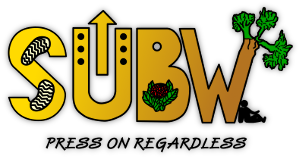7 – 8 October 1977
by David Noble
On the Thursday night I hitched up the Putty Road to find Tom Williams already waiting at the Canoe Creek Firetrail turn-off. We shouldered our light packs and set off along the 6-7 mile roadbash.
To pass the time we compared tales of hitching out along the Putty Road. From Windsor I’d got a lift with a driver who’d just bought a car – a great bargain for $300. However, at Colo Heights, I had to leave him discussing, with the proprietor of the service station, how to fix up his gearstick – since it had just sheared off. Tom had had an even more eventful ride up, but I won’t relate the details here.
Shortly after Grassy Hill we were surprised to see the dark shape of an animal on the road. We thought it was a wombat. It had been one of Tom’s long standing ambitions to catch a wombat so he ran up close to the dark shape. Instead of running away the beast gave out a loud growling snort and Tom backed away. We wondered what this animal was while we fumbled trying to light a match (we didn’t have a torch). In feeble match light we saw that it was indeed a wombat and as it also realised what we were it took off through the scrub; we regained our brisk stride and soon reached our campsite at the top of Pass 13.
Up bright and early the next morning we set off down the pass. It is fairly straightforward and we soon arrived at the river; after a drink and filling water bottles we soon climbed Pass 17 onto the Savage Ridge. The ridge is a bit scrubby (not really bad for the area) but is rewarding in the fine views of the Colo Gorge. We reached Savage in time for an early elevenses (we weren’t sure of the time as neither of us had a watch). From Savage we crossed a saddle containing a rock exhibiting some amazing circular whirls. Soon after, Tom realised another of his ambitions by catching a Goanna. It was then an easy scramble down to Tambo Creek. We walked down the creek a short distance and climbed out the other side via a short tributary creek. The ridge between here and Main Creek is fairly open due to a bushfire or aerial burning.
We had chosen a route to cross two of the three branches of Main Creek at a place where they are very close together. We had lunch at the second branch of Main Creek. After this, we pushed our way through thick tangled scrub to the top of the ridge. Here there is a large open rocky area and some faint sharpening grooves. The third branch of Main Creek was fairly easy to cross and we filled up our water bottles expecting a ridge top camp that night. I decided it was time to put on the long pants.
We soon climbed up the ridge to Mt Mistake, leaving our packs on the first summit and dashing through the scrub to reach the highest point. It was Tom’s first visit to this lofty summit but it would not be an exaggeration to say he was enraptured by the fine views. Hoping, if possible, to reach the Un-named Creek that night we didn’t linger very long at Mt Mistake (thank goodness the log book doesn’t have much reading in it).
The ridge towards the Maiden is fairly pleasant walking but we stopped just short of the Un-named Creek for that night. Next morning after another early start we dropped into the creek. It was fairly slow to start with but soon improved to the usual rocky slabs and small cascades. All the tributaries of the Colo – Pinchgut Ck, Tambo Ck, Main Ck and Angorawa Creek – exhibit these sections of open slabs and they provide excellent walking. This un-named creek (or named the Un-named Creek), although a tributary of the Wollangambe, is one the best of these creeks. Chris Cosgrove had told us of an abseil required to avoid a swim in the lower section of the creek. We were carrying 60 ft of No 2 for this, but when we got to the pool we found that as usual because of Chris’ exaggeration factor the rope wasn’t required
Boulder-hopping brought us quickly to the Wollangambe and then it was only a few hundred yards to the Colo. We had decided to climb the Island directly via Straws Gully. This steep gully leads straight to the summit and was named when Tom Williams and Ian Watson drew straws to see who would have to lead the way on a previous trip. The gully went OK involving some steep tricky scrambling
The log book on the summit was almost as sparse as the other two so we had an early lunch there, admiring the best views of the walk. On the way to the firetrail we thought we had sufficient time to try some boulder problems. The firetrail, although a ten mile road bash, wasn’t really unpleasant, and we soon reached the farm at the Putty Road. After looking at the incredible number of “no through road” signs we decided to skirt the farm, and five minutes brought us out to the Putty Road. Tom won the straw to decide on the hitching order but after ten minutes we both got a lift together to Windsor arriving about 4 pm. A dollar’s worth of grease each and a few schooners provided a fitting end to the walk.
In retrospect, we thought the Northern Three Peaks: Savage – Mistake – Island, from the Putty Road, was an excellent “burn” walk. It is roughly as hard as the traditional Three Peaks, the main difficulties being scrub, route-finding and navigation. It is about 40 miles long and has approximately 10,000 feet of climbing. A harder alternative would be the Four Peaks, including Mt Barakee. We weren’t sure how long the Northern Three Peaks would take and had an extra day in reserve. Except for the night roadbash, the walk took only a day and a half.

